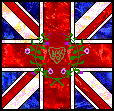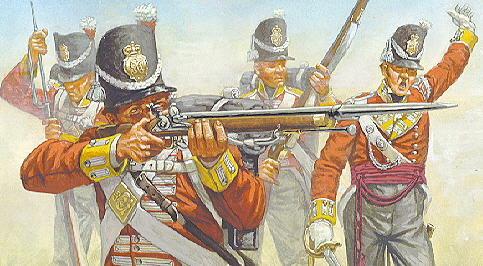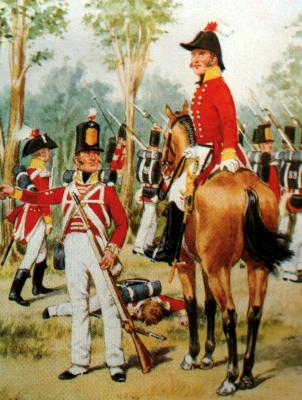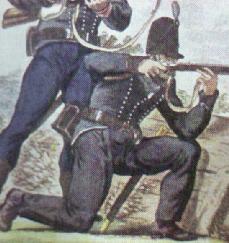
British Infantry

Organisation
List of British Infantry Regts and Facing Colours
Most British infantry regiments were composed of 2 battalions. Normally only 1 battalion was sent on campaign, the other serving as a depot unit at home.
Average battalion strengths while on campaign were as follows:
- Line and Light - 500 to 600 men (50-60 men per coy)
- Guard and Highland - 1000 men (100 men per coy)
Each battalion was made up of 8 centre coys, 1 light and 1 grenadier coy. The light and grenadier coys were also known as the flank coys - because the grenadier coy would always form up on the right of the line, while the light coy formed up on the left of the line.
Uniforms

British infantry in post-1812 uniform. Note the Belgic shako. The officer wears a shako instead of a bicorne. The officer also wears a coat with shortened tails. This regiment has yellow facings - note the collars, cuffs and shoulder straps - and the officer's lapels. Graphic reproduced with kind permission of Hät Industrie.
British infantry wore a standard pattern red jacket throughout the Napoleonic wars. (exception: Rifle regts, KGL Light regts).
Trousers in the Peninsular were either white (summer) or grey (winter). At Waterloo, all wore grey overalls.
Up until 1812, British infantry wore the so-called stovepipe shako with plume in front. After 1812, the stovepipe shako was replaced with the Belgic shako (with false front and plume on the left). However, Light infantry, Rifle regts and the 28th Line regt continued to wear the stovepipe shako.
Facings (i.e. collar and cuffs) varied according to regiment (click here for a list of British infantry regiments and facing colours.)
Plumes were white over red for centre coys, green for light coys and white for grenadiers. (exception: centre coys of the 42nd had red plumes, light coys - red over green, and grenadier coys - red over white). All coys in Light and Rifle battalions wore green plumes. In addition, flank coys and all coys in Light battalions had 'wings' on their shoulders.
Highland regts wore a highland bonnet in place of shako. With the exception of the 71st to 75th regts, all Highland regts wore kilts (pattern varied according to regiment). Note that the 71st regt wore a band of Highland dicing around their shakos. The other non-kilted Highland regts wore the usual British Line Infantry uniform.

British infantry in pre-1812 uniform.
Note the stovepipe shako. Take note too of the officers' uniform - bicorne and long coattails.

Highland uniform.

British Rifleman of the 95th Regt.
Note the dark green uniform with black facings piped white.
[an error occurred while processing this directive]